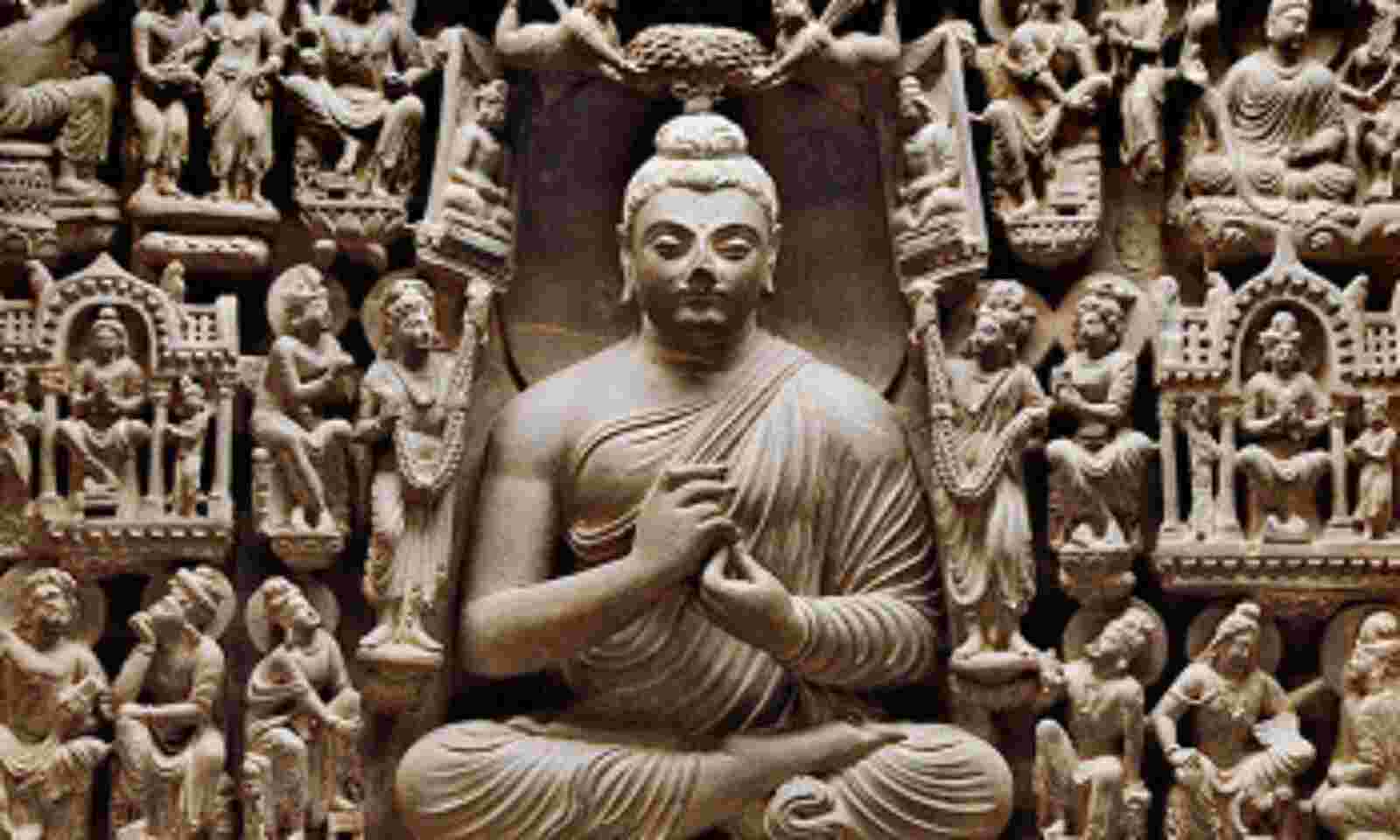What are the various sects of Buddhism?
In the second council, which was held at Vaishali, the Buddhist order was split into two schools:- The Sthaviravadins: It followed strict monastic life and rigid disciplinary laws as originally prescribed.
- The Mahasanghikas: The group which followed modified disciplinary rules was called the Mahasanghikas.
- In the first century CE, during the period of Kanishka, some doctrinal changes were made.
- Mahayana developed after the 4th Buddhist Council.
- It was in opposition to the Hinayana group, which believed in the orthodox teachings of the Buddha; those who accepted the new ideas belonged to the Mahayana sect.
- They made images of the Buddha and worshipped it as a god.
- Mahayana developed after the 4th Buddhist Council.
| Sects | Tenets |
| Hinayana (Lesser vehicle)/Theravada |
|
| Mahayana (Greater vehicle) |
|
| Vajrayana: (Diamond Vehicle) |
|
| Zen |
|
| Navayana |
|
Spread of Buddhism
- Social and economic changes:
- Many people were disenchanted with the caste system and the rigid social hierarchy and were seeking a more egalitarian and inclusive spiritual path.
- Influence of the Buddha's teachings:
- The Buddha's teachings were compelling and resonated; emphasis on compassion, non-violence, and the importance of personal responsibility appealed to many.
- Conversion of rulers and elites:
- The conversion of rulers and elites played a significant role in the spread of Buddhism.
- For example, according to tradition, Ashoka sent his son Mahendra and his daughter Sanghamitra to Sri Lanka to preach Buddhism. He also established many monasteries and contributed liberally to the sangha.
- Monastic network:
- The establishment of a network of monasteries and the spread of the monastic tradition contributed to the spread.
- Accessibility of the Buddha's teachings:
- It was accessible to people from all walks of life, regardless of their caste or social status.
- Language:
- The use of Pali to explain the doctrines also helped in the spread of the religion, Unlike Brahmanical religion, which had limited itself to the use of Sanskrit.
- Other factors for spread:
- Early Diffusion: Spread within India and neighbouring regions
- Trade Routes and Buddhist Pilgrims: Transmission to Central Asia and China
- The Silk Road and the Transmission to Central Asia and Beyond
- Establishment in Southeast Asia: Adaptation and Syncretism
- For example, Southeast Asian Buddhism adapted to local beliefs and practices, incorporating local deities, ancestor veneration, and the use of amulets due to its contact with diverse religious and philosophical traditions, such as Hinduism, animism, and Daoism.
- Modern Spread of Buddhism: Immigration and Conversion to the West.
How did Buddhism reach central India?
- There are two accounts-
- Ashoka’s son Kushtana founded the Khoisan kingdom around 240 BCE in the present-day Xinjiang province of China and introduced the Buddhist religion.
- Kaniska, who ruled over northern India, Afghanistan and parts of Central Asia, encouraged the spread of the religion.
- Over the centuries, his message spread across the subcontinent and beyond – through Sri Lanka and across the seas to Myanmar, Thailand and Indonesia.
The Institution of Sangha
The Buddha laid the foundations of the Buddhist Sangha. He preached most of his sermons at Shravasti. The Sangha was the religious order of the Buddhists. It was a well-organised and powerful institution which popularised Buddhism.- Donor: Anathapindika, the rich merchant of Shravasti, became his follower and made liberal donations to the Buddhist order. Soon he started visiting places to propagate his sermons.
- Membership: It was open to all persons above fifteen years of age, irrespective of caste and sex. Criminals, lepers and persons affected by infectious diseases were not given admission into the Sangha.
- Women: Initially, the Buddha was not in favour of admitting women in the Sangha. However, he admitted them at the repeated requests of his chief disciple Ananda and his foster mother, Mahapajapati Gotami. On admission, the monks had to ceremonially shave their heads and wear yellow or saffron robes.
- Routine of Monks: Monks were expected to go on a daily round in order to preach Buddhism and seek alms. During the four months of the rainy season, they took up a fixed abode and meditated. This was called the retreat or ‘vasa’.
- Education:
- The Sangha also promoted education among the people. Unlike Brahmanism, people of different orders of society had entry to education.
- Naturally, the non-brahmins who were deprived of education got access to education in Buddhism, and thus education reached wider sections of society.
- Principles of Sangha:
- The Sangha was governed by democratic principles and was empowered to enforce discipline amongst its members.
- There was a code of conduct for the monks and nuns, and they were bound to obey it. The Sangha had the power to punish the erring members.
What were the causes of the decline of Buddhism?
Buddhism faced divisions from time to time. The division into various splinter groups like ‘Hinayana’, ‘Mahayana’, ‘Vajrayana’, ‘Tantrayana’ and ‘Sahajayana’ led Buddhism to lose its originality.- The decline of Buddhism in India was a gradual process and occurred due to a combination of internal and external factors.
- Loss of royal patronage: The decline of Buddhism was hastened by the loss of royal patronage after Harshavardhana. The Buddhist kings were replaced by Hindu kings, who supported the revival of Hinduism and the Brahmanical tradition.
- For example, The Vedic religion got royal patronage first from Pushyamitra Sunga and later from the imperial Guptas.
- The role of the exponents of the Bhakti movement, like Ramanuja and Ramananda, also helped to restore the glory of the Vedic religion.
- Invasion of foreign rulers:
- The invasion of foreign rulers like the Shakas, Kushans, and Huns also contributed to the decline of Buddhism. These rulers were not Buddhists, and they patronised the Brahmanical tradition, which led to the decline of Buddhism.
- The Rajput rulers, who could not reconcile to the Buddhist concept of nonviolence and as ardent advocates of Vedic religion, started persecuting the Buddhists.
- The invasion of Arabs and Turks forced the Buddhist monks to flee from India and seek asylum in Nepal, Tibet and Ceylon. In consequence, Buddhism faded away in India.
- Competition from other religions: The rise of other religions like Jainism and Hinduism also contributed to the decline of Buddhism. These religions competed with Buddhism for followers and resources, and the Brahmanical tradition was successful in attracting a large number of followers.
- Decay of monasteries: The decay of monasteries and the corruption of Buddhist monks also contributed to the decline of Buddhism. The monasteries became centres of wealth and power, and the Buddhist monks became involved in worldly affairs, which went against the basic principles of Buddhism.
- Lack of vernacular literature: The lack of vernacular literature also contributed to the decline of Buddhism. The Buddhist texts were written in Pali and Sanskrit, which were not understood by the masses. As a result, the teachings of Buddhism were not widely disseminated.
| Terminologies associated with Buddhism | |
| Bodhisattva | A being who has attained enlightenment but chooses to stay in the cycle of rebirth to help others achieve liberation. |
| Five Precepts | Basic moral guidelines for lay Buddhists, which include refraining from killing, stealing, sexual misconduct, lying, and taking intoxicants. |
| Four Noble Truths | The Buddha's fundamental teachings on the nature of suffering and its causes and the path to liberation from suffering. |
| Eightfold Path | The Buddha's prescription for achieving liberation from suffering, which includes right understanding, intention, speech, action, livelihood, effort, mindfulness, and concentration. |
| Three Jewels | The Buddha, the Dharma, and the Sangha, which is considered to be the refuge for all Buddhists. |
| Vipassana | A form of meditation that focuses on insight into the nature of reality and the mind. |
| Zazen | A form of meditation in Zen Buddhism that involves sitting in a specific posture and focusing on the breath. |
| Anicca | The concept of impermanence, states that all phenomena are constantly changing and without permanent existence. |
| Anatta | The concept of non-self, which states that there is no permanent, unchanging self or soul in human beings. |
| Sangha | The community of Buddhist monks and nuns who follow the Buddha's teachings and live in monastic communities. |
| Dharma | The teachings of Buddha |
| Pavarana | Means “inviting admonition; ” This refers to inviting one’s fellow monks to offer reprimands for any offences or misdeeds committed during the three-month retreat when monks lived communally. |
Last updated on December, 2025
→ Check out the latest UPSC Syllabus 2026 here.
→ Join Vajiram & Ravi’s Interview Guidance Programme for expert help to crack your final UPSC stage.
→ UPSC Mains Result 2025 is now out.
→ UPSC Notification 2026 is scheduled to be released on January 14, 2026.
→ UPSC Calendar 2026 is released on 15th May, 2025.
→ The UPSC Vacancy 2025 were released 1129, out of which 979 were for UPSC CSE and remaining 150 are for UPSC IFoS.
→ UPSC Prelims 2026 will be conducted on 24th May, 2026 & UPSC Mains 2026 will be conducted on 21st August 2026.
→ The UPSC Selection Process is of 3 stages-Prelims, Mains and Interview.
→ UPSC Result 2024 is released with latest UPSC Marksheet 2024. Check Now!
→ UPSC Prelims Result 2025 is out now for the CSE held on 25 May 2025.
→ UPSC Toppers List 2024 is released now. Shakti Dubey is UPSC AIR 1 2024 Topper.
→ UPSC Prelims Question Paper 2025 and Unofficial Prelims Answer Key 2025 are available now.
→ UPSC Mains Question Paper 2025 is out for Essay, GS 1, 2, 3 & GS 4.
→ UPSC Mains Indian Language Question Paper 2025 is now out.
→ UPSC Mains Optional Question Paper 2025 is now out.
→ Also check Best IAS Coaching in Delhi
Spread and Decline of Buddhism in India FAQs
Q1. What is bodhisattva in Buddhism?+
Q2. Who is Maitreya?+

















